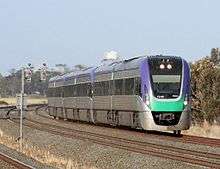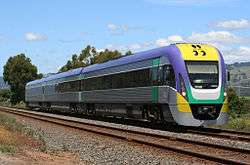V/Line VLocity
| V/Line VLocity | |
|---|---|
|
VL38 at Yarragon in December 2008 | |
 | |
| Manufacturer | Bombardier Transportation |
| Built at | Dandenong |
| Constructed | 2004- |
| Entered service | December 2005 |
| Number under construction | 226 |
| Number in service | 177 (April 2016) |
| Number scrapped | 1 |
| Formation | 3 carriages |
| Fleet numbers | VL00-VL28, VL30-VL75 |
| Capacity | 216 seats |
| Operator(s) | V/Line |
| Depot(s) | Southern Cross |
| Line(s) served |
Ballarat Bendigo Geelong Gippsland North-East |
| Specifications | |
| Car length | 25.25 m (82 ft 10 in) |
| Width | 2.92 m (9 ft 7 in) |
| Doors | 4 per carriage |
| Maximum speed | 160 km/h (100 mph) |
| Prime mover(s) | 1 Cummins QSK-19R per carriage |
| Power output | 559 kW (750 hp) per carriage |
| Transmission | Voith T312 hydraulic transmission |
| Acceleration | 0.9 m/s2 (3.0 ft/s2) |
| Deceleration |
0.95 m/s2 (3.1 ft/s2), emergency: 1.12 m/s2 (3.7 ft/s2) |
| Auxiliaries | Cummins 80 kW (110 hp) generator |
| Coupling system | Scharfenberg coupler |
| Track gauge | 1,600 mm (5 ft 3 in) |
The V/Line VLocity is a diesel multiple unit train built by Bombardier Transportation, Dandenong for V/Line.
History




Design origins & testing
In November 2001 National Express signed a contract with Bombardier Transportation for 29 two-carriage diesel multiple units.[1] This was later extended to 38. The design was an evolution of the Xplorer/Endeavour railcars.[2]
Original plans were for the 29 sets to be fitted with 2+3 seating for a total capacity of 173 passengers per two-carriage set, but in February 2003 this was changed to 144 seats in a 2+2 formation.[3]
Testing revealed noise levels were too high in the cabin,[4] delaying the introduction of the trains into service while the completed sets were modified.
Into service
The VLocity was introduced into service on the Ballarat line on 22 December 2005. followed by the Geelong and Bendigo lines on 3 February 2006 and 24 February 2006, respectively. Services to Traralgon and Seymour were introduced in September 2006. In addition, the Ararat and Echuca services are operated by VLocitys. From 2010, one Ballarat line service each day was extended to Maryborough.[5]
The 160 km/h services commenced on 3 September 2006, to Ballarat, Bendigo and Geelong, and to Traralgon on 15 September 2006. Outside these areas they may travel up to 130 km/h.
On 10 November 2008, seven-carriage-long VLocity trains commenced regular operation on peak-hour Geelong line services. Previously, the longest trains were six carriages.[6]
Additions to the fleet
After the initial order of 38 units, a further two VLocity units were later ordered to bring the total to 40, along with 22 new intermediate trailers to be inserted in the middle of existing VLocity sets. The first 14 were promised during the 2006 State Election,[7] and the order was placed in December the same year.[8] The order for the next eight was announced on 12 October 2007.[9]
In July 2008, the State Government ordered nine new three-car units, and an additional intermediate car to be inserted into an existing two-car unit,[5][10][11] with an extra four carriages added in February 2009.[12] The final unit of the order was delivered in September 2011.
In November 2012, the State Government announced an additional 40 carriages will be delivered between 2014 and 2016. The order comprised seven additional 3-car sets plus 19 intermediate cars to increase the remaining 2-car sets to 3-cars.[13][14][15][16]
In March 2014, the order for 40 carriages was increased to 43.[17] Further orders were placed for 21 carriages In May 2015 and 27 carriages in April 2016.[18][19] Once all have been delivered, the fleet will comprise 75 3-car sets.[16]
Livery modifications
In March 2008, newly built VLocity set VL41 was outshopped with an altered cab livery following recommendations in recent level crossing accident reports to make trains more visible to motorists. Portions of reflective yellow were added to the cabs, along with more reflective silver directly beneath the cab windscreen. All units were retrospectively treated.
In June 2010, newly built set VL42 was released in a new livery of crimson stripe at roof level replacing the purple, and red replacing the green, a red stripe along the car body below the windows, white doors, and yellow front. The set also received high-intensity discharge (HID) headlights which project light for up to 1 kilometre, modified windscreen wipers and cab windows.
In 2014 VL40 had a new Public Transport Victoria livery applied. All sets from VL52 were delivered in this livery.
Passenger experience
The seating layout for the VLocity is 2+2, with a mix of club-style seats facing each other, and aircraft-style rows. The seats can't be rotated to face any particular direction, and seat backs do not recline. Four wheelchair spaces are provided in each set through the provision of tip-up seats. The VLocity offers economy-class seating only, although the seat width is equivalent to first class seating on V/Line locomotive-hauled services.[20] In response to passenger feedback, the seatback angle in the intermediate carriages was made 2.5 degrees more upright than the original carriages.[21] New deliveries from July 2010 onwards (VL42 and above) featured a changed seatback angle and new seat fabrics.[22]
While VLocity carriages have tinted windows, they lack the curtains as provided by older V/Line rolling stock. Passengers may move freely between the two or three semi-permanently coupled vehicles in a set, but not between the sets themselves. Conductors move between coupled sets at station stops.
Tables were installed in one unit (VL28) for evaluation purposes,[23] but were later removed. In three-car VLocity units, 32 seats in the intermediate carriage have fold-down tray tables,[24] much like the first class seats on locomotive-hauled services.
Overhead racks exist for small baggage, while larger baggage is stored in the middle of the unit, with some spaces large enough for surfboards and bicycles. In January 2008, passengers were banned from taking bicycles on VLocity trains during peak hours, despite the designated bike area,[25] with the ban repealed in February 2008.[26]
Technical
Power is provided by a Cummins QSK 19R diesel engine (559 kW) in each car. VLocity units use Scharfenberg couplers enabling them to operate with other VLocity units.
The VLocitys operate on the broad gauge, as with most other V/Line services. The bogies were manufactured by Bombardier's Derby Carriage and Wagon Works, and are fully gauge-convertible to standard gauge..
Criticisms
As the VLocity seating layout is 2+2, instead of the 2+3 seating provided in other V/Line saloon-type carriages, the VLocity is less suited to crush loads than older rolling stock. A single VLocity car seats around 70 passengers, compared to 89 in the previous generation Sprinter with its narrower 2+3 seats.
The Regional Fast Rail project for which the VLocitys were built was criticised for cost blow-outs during construction. These included the cost of installing extra safety measures deemed necessary for 160 km/h operation, which were added to the project after the Waterfall rail accident in New South Wales.[27]
Accidents
On 28 April 2006, set VL29 was involved in a collision at a level crossing at Trawalla while travelling from Ararat. It collided with a large triaxle road trailer carrying a 16-tonne block of stone and two heavy press machines. The front of the train withstood the impact with the trailer, but the press machines were thrown loose, striking and penetrating the cab. At the time of the impact, three people were in the cab, the driver (who was seriously injured) and two off-duty Pacific National drivers (one of whom was injured, and the other killed). As the train continued through the crossing, the rear trailer swung around and the stone block was thrown off, striking and partially penetrating the side of the leading car (1129), killing the mother of the train driver, who had been travelling as a passenger. The final injury count is unknown. The unit had been in service for seven days before the accident.[28] After the accident, both cars were taken to Newport Workshops for examination. Carriage 1129 suffered the most damage and was written off. Carrriage 1229, having received relatively minor damage, was sent to Bombardier, Dandenong for repairs. It was later renumbered 1241 and marshalled together with new cars 1141 and 1341.
On 5 May 2006, VLocity set VL04 travelling on the 09:38 service from Melbourne to Ararat collided with a car at the protected Rockbank level crossing near Melton. Thirty train passengers and the driver of the car were taken to hospital.
Service withdrawals
On 15 January 2016 a VLocity set failed to activate boom gates at the Progress Street level crossing in Dandenong.[29] This led Metro Trains to ban all sets from operating on suburban lines until the issue has been resolved.[30]
Services
VLocities are used on lines including:
- North-East line to Seymour
- Gippsland line to Traralgon and Sale
- Bendigo line to Kyneton, Epsom, Eaglehawk and Echuca
- Geelong line to Geelong, South Geelong, Marshall and Waurn Ponds
- Ballarat line to Melton, Bacchus Marsh, Ballarat, Wendouree, Ararat and Maryborough
References
- ↑ Annual Report December 2001 National Express
- ↑ Vlocity Cars for V/Line Passenger Rail Technical Society of Australasia, South Australian Chapter newsletter July 2007 page 6
- ↑ http://web.archive.org/web/20050724130141/http://www.dpc.vic.gov.au/domino/Web_Notes/newmedia.nsf/798c8b072d117a01ca256c8c0019bb01/9f615152ebe651b1ca256cd900018a0b?OpenDocument
- ↑ "Fast trains strike costly sound hitch". The Age. 11 October 2005. Retrieved 2006-04-25.
- 1 2 "More Regional Trains & Return of Passenger Services to Maryborough". Media Release from the Premier of Victoria. V/Line. 8 December 2008. Retrieved 2008-12-08.
- ↑ "Super-Sized Trains for Geelong to Ease the Squeeze". Media Release from the Minister for Public Transport. V/Line. 7 November 2008. Retrieved 2010-07-05.
- ↑ "Provincial Victoria: Moving Forward - Not Back" (PDF). p. 8. Retrieved 2006-11-11.
- ↑ "Media Release: 1,000 Plus New Seats for Regional Rail commuters". www.dpc.vic.gov.au. Retrieved 2008-04-03.
- ↑ "Media Release: Extra Carriages to Boost Capacity on Regional Trains". www.dpc.vic.gov.au. Retrieved 2008-04-03.
- ↑ "New Train Sets to Boost Capacity on Regional Trains". Media Release from the Premier of Victoria. V/Line. 31 July 2008. Retrieved 2008-07-31.
- ↑ More VLocity in Victoria Railway Gazette International 1 August 2008
- ↑ Victorians seek more VLocity Railway Gazette International 25 February 2009
- ↑ "State Government to buy 40 new V/Line carriages". Herald Sun. 26 November 2012.
- ↑ Bombardier to supply more VLocity cars Railway Gazette International 26 November 2012
- ↑ VLocity Railpage
- 1 2 VLocity Vicsig
- ↑ "New VLocity train for the V/Line network". 24 March 2014.
- ↑ $257 Million for New Regional Trains and Local Jobs Premier of Victoria 1 May 2015
- ↑ Public transport investments in 2016/17 Victorian Budget Public Transport Victoria 27 April 2016
- ↑ "New VLocity trains". V/Line. Retrieved 2006-11-09.
- ↑ "V/Line is expanding". V/Line. Retrieved 2006-11-09.
- ↑ wongm's rail gallery: Interior picture of VL00 showing new interior arrangement http://railgallery.wongm.com/vline-bits/E105_9856.jpg.html
- ↑ Tables installed in VL28, V/LineCars.com
- ↑ "Looking down VLocity centre car 1341 and the tray tables". Wongm's Rail Gallery. railgallery.wongm.com. 4 July 2008. Retrieved 2010-07-05.
- ↑ Train bike ban sparks protest ABC News 23 January 2008
- ↑ Minister lifts bicycle ban on peak-hour trains The Age 15 February 2008
- ↑ Fast Rail in $200m Blow Out The Age 14 December 2004
- ↑ Two Dead in Train Crash The Age 28 April 2006
- ↑ http://www.theage.com.au/victoria/boom-gate-safety-issues-with-vline-vlocity-trains-known-for-more-than-two-years-20160119-gm9lkj.html
- ↑ http://www.heraldsun.com.au/news/wheel-issue-heat-delays-regional-commuters-on-vline-trains/news-story/aba6a48efb70866db71807356fe0aef4
